- Accommodation
- What's On
- Things to Do
- Food and Drink
- Explore Cumbria
- Ideas and Inspiration
- Christmas & New Year
- Itineraries - Great days out
- Starring Great Britain: The Lake District, Cumbria
- Lake District, Cumbria Bucket List
- Selfie Guide
- Dark Skies Cumbria
- Cumbria Tourism Awards 2025
- The National Trust in the Lake District
- Sunny day ideas
- Rainy day ideas
- Romantic Breaks
- Family Holidays
- Dog Friendly Holidays
- Bespoke Holidays
- Caring for the environment
- Plan Your Visit
- Weddings
- Conferences & Event Spaces
- Prizes & Guides
- Let's Go Lake District Blog
- Special Offers
You are here: Home > Explore Cumbria > Lakes of the Lake District
The clue is in the name: there are a lot of lakes in the Lake District. Sixteen, to be precise, though officially, only one of the sixteen - Bassenthwaite - is officially a lake by name; all of the others are called meres or waters.
And while most of the lakes were created by glacial deposits during the last Ice Age, two of them - Thirlmere and Haweswater - were much smaller lakes transformed into reservoirs so that the city of Manchester could have water. Haweswater was enlarged by the flooding of the Mardale Valley near Penrith in the 1930s; Thirlmere was raised 50 years earlier by submerging the villages of Amboth and Wythburn.
The largest of the lakes - and the largest lake in all of England - is Windermere, which is over 11 miles long, nearly 5.7 square miles and (fun fact) holds 300 billion litres of water. The deepest is Wastwater in the west of the county, with a maximum depth of 243 feet. The smallest is Brotherswater in the Hartsop Valley of eastern Cumbria, a mere (see what we did there?) 0.07 square miles in size. In fact, Brotherswater is so small that there’s some debate over whether it’s a lake at all or a tarn, a glacial pool usually found in the mountains. And in Cumbria, there are officially 197 of them (if you count Brotherswater).
Some of the most best-known tarns include Blea Tarn, Little Langdale Tarn, Sunbiggin Tarn and Tarn Hows. If you’re so inclined, you can take part in a bit of ‘tarn dipping,’ which is the watery alternative to doing the Wainwrights - and a lot less strenuous as all you have to do is dip your hand in a tarn to tick it off the list. One of the real pleasures of tarn dipping is that you’ll end up exploring some of the most beautiful parts of the Lake District. The high water mark for tarn dippers is Foxes Tarn on the side of Scafell Pike, England’s tallest mountain: just getting to it takes some effort, but you’re rewarded with some pretty fabulous views (plus the respect of all serious tarn dippers).
And if you want to pay your respects to Alfred Wainwright, his ashes are scattered about Innonimate Tarn, a lovely walk from Buttermere.
While lakes and tarns gets most of the attention, not to be ignored are Cumbria and the Lake District’s rivers, which besides feeding water into the lakes are the ideal destination for anglers and wild swimmers.
An A - Z guide to Cumbria's best-known Lakes
For the uninitiated, a visit to the Lake District can both be an exciting but daunting prospect. There’s so much to see, but which lake to visit first? Most importantly, how to get there? The hilly, winding country roads will find explorers are spoiled for choice, making decision-time just as time-consuming as doing that essential research.
But, rest-easy. Whether you’re looking for a popular lake to make a splash in, or somewhere for a more intimate experience, our team has put together this guide to Cumbria’s best-known lakes, how to find them; and what to look for when you get there. While 16 bodies of water are officially classified as “lakes” in the Lake District, that number jumps quite significantly if everything with ‘lake’, ‘water’ or ‘tarn’ in its name is taken in to account. What each one has in common, however, is that they all offer visitors the perfect opportunity for boat trips, sailing, canoeing, swimming; and even stone skimming.
While it’s by no means exhaustive, this list covers many of the ‘household names’ and covers just over half of The Lake District’s best-known bodies of water - and yes, we know there’s only one ‘lake’ by name, which rather conveniently, provides us with a perfect location to kick off this handy A-Z (or in this case, B-W) guide…
Bassenthwaite Lake
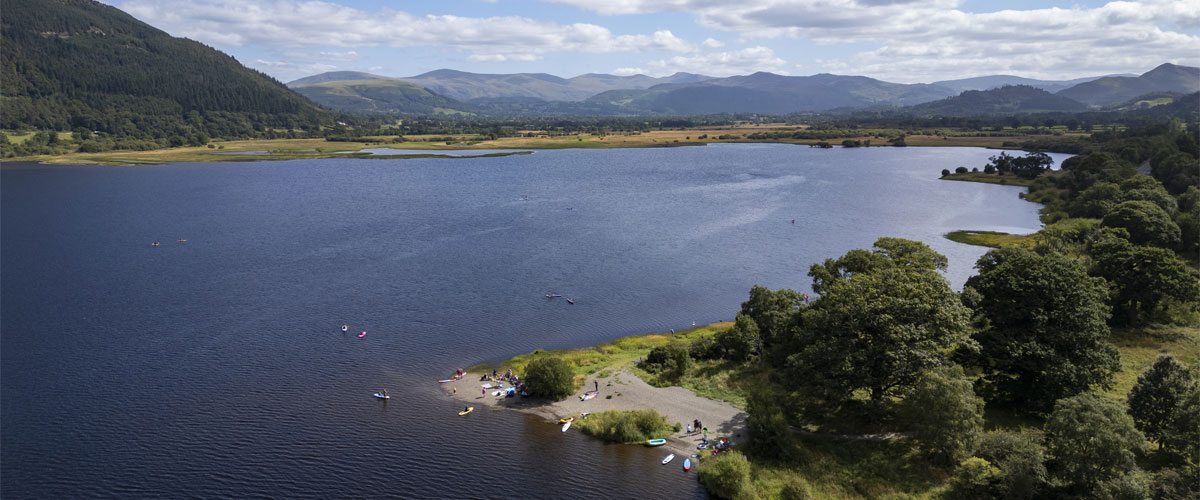
Four miles long, around ¾ of a mile wide and the most northerly lake on this list, Bassenthwaite Lake is one of the largest in Cumbria and bathes in the shadow of Skiddaw. Flanked by the A66 on its western shore, Bassenthwaite is easily accessible by road and public transport, with plenty of lay-bys to pull over and soak up the views. For a quieter moment, why not take the A591 on the lake’s eastern side and follow a public footpath to the shore for a more tranquil moment?
Buttermere
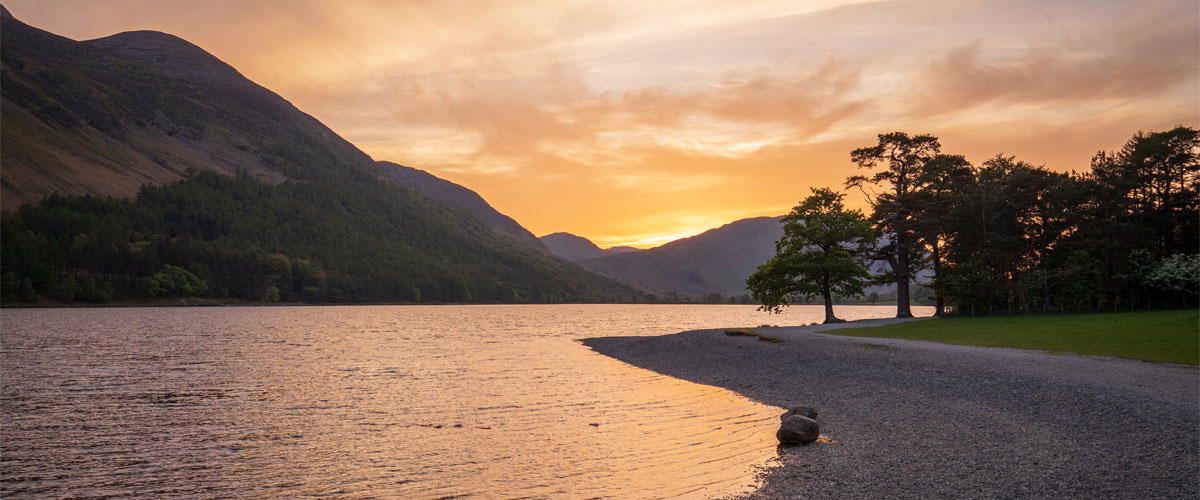
From one of the largest lakes on this list, to one of the smallest lakes, Buttermere offers peace and quiet in spades. With only one road passing the shore for a short distance on its eastern tip, a drive over the Honister Pass brings you out to a perfect place to pull over and head down to the water’s edge.
Coniston Water
.jpg)
Perhaps most famous for the adventurous exploits of Donald Campbell in his legendary Bluebird craft – as well as being infamous as the location of the record-breaking speed king’s untimely and tragic death, Coniston water is one of the Southern Lake District’s most popular lakes, surrounded by famous villages (including Coniston Village) and stunning woodland. Under the popular peak, Coniston Old Man, this is also the scene of the classic children’s tale, Swallows and Amazons. Why not bring a canoe along and re-live their adventures? You can also sail on the Coniston Launch or the National Trust’s Steam Yacht Gondola if your arms tire easily... The trip to get there is just as picturesque as the views upon arrival, too.
Crummock Water
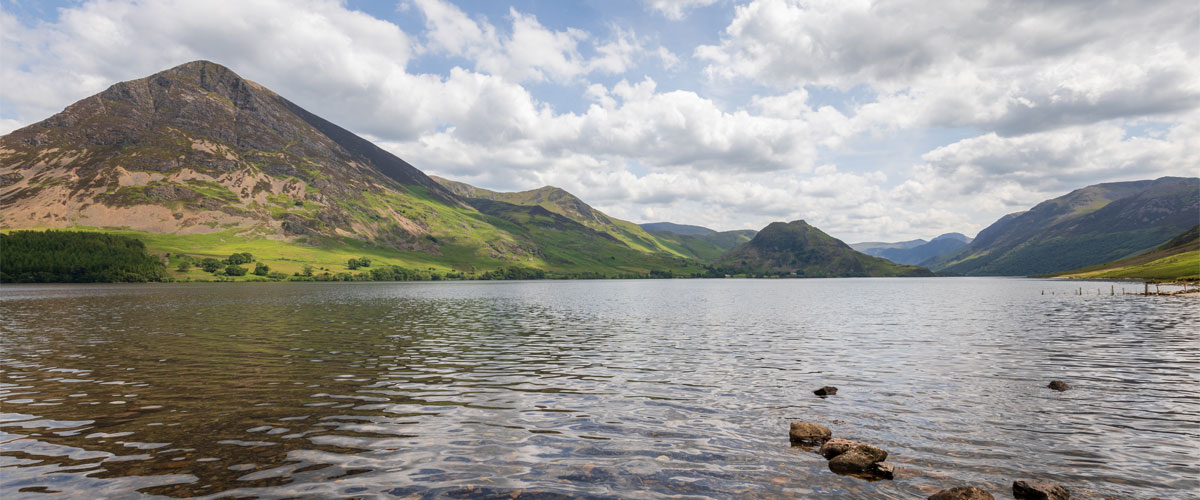
Popular with wild swimmers, Crummock Water is off the beaten-track, but well worth a visit. Accessed via the B5289, Crummock Water’s close neighbours Buttermere and Loweswater can also both be enjoyed during the same journey. For a big adventure day, hike 3 lakes in a day and finish up with a re-energising wild swim.
Derwentwater
.jpg)
Popular with campers thanks to the Keswick Campsite right on the shoreline, Derwentwater boasts no fewer than seven lakeside marinas and several little islands to explore. The lake was used for the filming of Star Wars: Episode VII The Force awakens, for the scene set on the planet of Takodana. Thankfully, the lake is a far more peaceful place than as depicted in the movie – but don’t be surprised if you do happen to see the occasional tourist in Star Wars attire.
The B5289 runs along the lake’s eastern shore and makes a great day out when combined with a visit to the dog-friendly town of Keswick itself. Find out more, here – and may the force be with you.
Elterwater

Split into three distinctly separate sections, Elterwater is another of the smaller lakes we’ve chosen to add to this list, for some near-perfect complete geographical isolation. Accessible via the B5383 followed by public footpaths, Elterwater is hidden from view by surrounding woodland in the Langdale Valley. Nestled west of the famous walking town of Ambleside, Elterwater gives ramblers the perfect place to stop and unwind after a walk up one of the many nearby peaks.
Ennerdale Water

The most westerly lake on this list, Ennerdale Water is another far-flung location considered by many Lake District enthusiasts as something of well-kept secret. Cut-off from the rest of the Lake District by road, access is only gained by entering via the National Park’s western side, along a small road on the lake’s north easterly edge from the A5086. While “taking the long way around”, so to speak, is unavoidable, a trip to Ennerdale Water gives visitors a great opportunity to check out some of Cumbria’s hidden gems en-route, like Cockermouth and Egremont, depending on the direction of travel.
Esthwaite Water

While not one of the best-known lakes in Cumbria, Esthwaite Water is sandwiched right between two of the best-known lakes; Coniston Water and the world-renowned Windermere. That proximity often results in Esthwaite Water being overlooked as a place to visit – a fact welcomed by those who like to get away from the more well-populated areas frequented by larger groups of sightseers. Just to the south of the stunning village of Hawkshead, it’s easy to find by road, but makes more sense to take a stroll there after enjoying what the village itself has to offer. Just follow your nose and keep your camera handy.
Grasmere
.jpg)
Another of the smaller lakes on this list, a visit to Grasmere – right next to its Grasmere village namesake, is definitely one to add to your ‘must-do’ list during your next Lake District getaway. It couldn’t be any more convenient if it tried. Located on the A591 on the route connecting the South Lakes with the North, you can’t miss it. If you’re driving, the earlier you set off, the better – especially if the weather is good. Set the alarm and be among the first people to welcome a new day almost slap-bang in the middle of the national park. Just remember the golden rule when visiting this lake: Don’t drop your Grasmere Gingerbread into the water. That would never do.
Haweswater
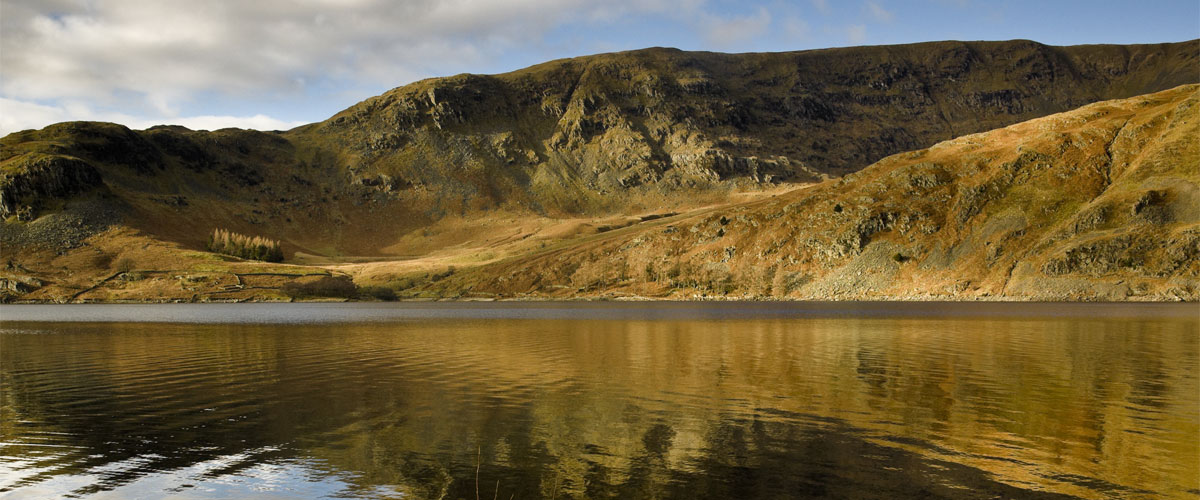
One of the national park’s most easterly lakes, Haweswater is another location which gives visitors the chance to enjoy some of the best opportunities to soak up some well-deserved moments of peace and quiet that can be found in Cumbria. Best-accessed by leaving the M6 at Shap, narrow twisty roads lead the way, with a largely deserted road hugging the lake’s eastern edge from top to bottom.
An early morning drive will take visitors on a picturesque journey down the eastern shoreline below the imposing morning shadow cast by nearby fells. Although partly man-made, this body of water – which is used as a reservoir, is well-worth the trip. The lakeside road goes nowhere other than to a parking area at its southern tip, from where visitors can contemplate a time before two villages were deliberately flooded to enable the valley to fulfil its destiny of becoming a storage area for Manchester’s drinking water needs.
Loweswater

Loweswater holds the unenviable and unofficial title as the lake that nobody seems to remember the name of. Completing a row of three lakes – which also includes Buttermere and Crummock Water, this small, picturesque lake is a welcome addition to any western Lake District itinerary. A circular walk means visitors can also enjoy views across the water or looking up at the surrounding fells from any point along its shoreline.
Rydal Water
.jpg)
They say there’s a perfect partner for everybody – and it’s no different for lakes, certainly in this case. Rydal Water goes hand-in-hand with Grasmere, with this small lake sharing a cosy, rural location with its slightly larger cousin. Separated by less than one mile, if you see one, you may as well see them both. With several walking routes available nearby, Rydal is served by Grasmere and in-turn, drains to Windermere.
Thirlmere
East of the mighty Helvellyn, Thirlmere is another reservoir which serves as a great day-out, flanked by the convenient A591 along its eastern side, with a more peaceful, meandering route along its western shore. As with Haweswater, the Manchester Corporation constructed a dam at the northern end in the 19th century, raising the water level and flooding the valley bottom to create a storage facility for the city’s water supply needs.
For the best views of Thirlmere, experienced walkers and climbers head up to Helvellyn, taking in the infamous Striding Edge – which can catch-out the ill-prepared. Lesser-experienced walkers are best off enjoying this lake from the shoreline.
Ullswater
.jpg)
Nine miles long and forged by a glacier, Ullswater is the second-biggest lake in the Lake District, with Ullswater ‘Steamers’ cruises enabling visitors to enjoy the full-length of the lake from Pooley Bridge in the north, to Glenridding in the south, via Howtown about halfway in between. Martindale Common is one of many fantastic walks which can be enjoyed nearby, for those who fancy putting in a few miles by both boat and on foot. The A592 runs along its entire north-western side, making it easy to find and enjoy.
Wastwater
.jpg)
Another lake carved into the landscape by a glacier, Wastwater holds the bragging rights for the title of ‘deepest lake in England’. Owned by the National Trust, Wast Water is also known for being another lake that’s not easy to reach directly, unless you’re a crow – in which case it’s not too long a flight. For readers who aren’t crows, however, access must be via the A595, which hugs Cumbria’s western coast.
Wast Water’s northern tip is at Wasdale Head – the site of a remote campsite and the last pub for miles – popular with walkers taking on a climb of England’s highest mountain, Scafell Pike. Accessible by a remote road and with a circular lake walk available, the feeling of rugged wilderness is hard to beat.
Windermere
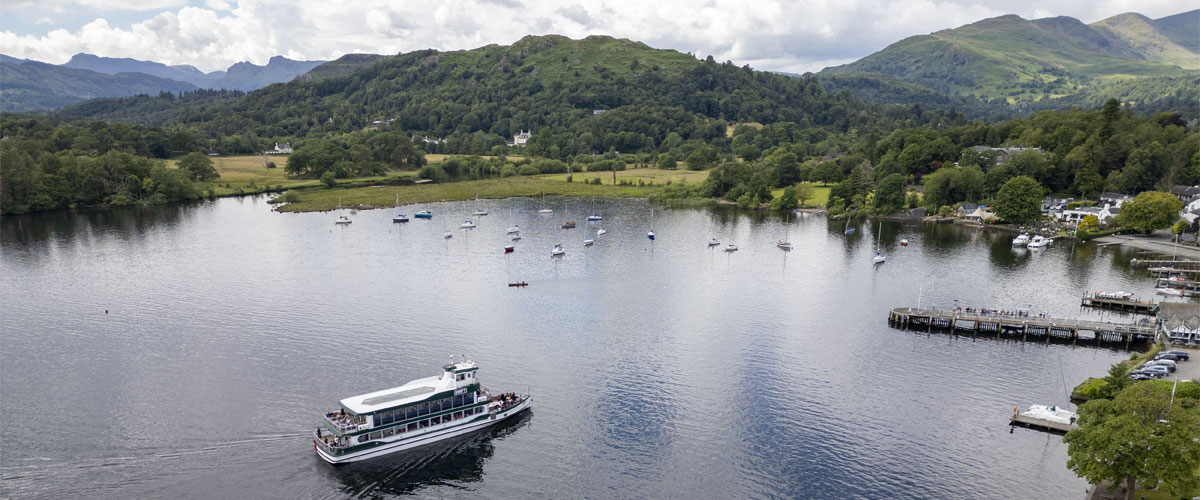
While the alphabet dictates that we leave England’s longest lake until last on this list, Windermere is a place that without doubt must be experienced at least once by every visitor.
From Lakeside near Newby Bridge at the southern tip, through Bowness-on-Windermere and the town of Windermere approximately half way up the lake, to Ambleside at the north, it’s the essential experience for newcomers. Sure to whet the appetite for all the other lakes on offer, Windermere has been made easy to explore and enjoy thanks to countless attractions working together to provide a full day-out without the need to use the car. Windermere Lake Cruises run services every day except Christmas Day, with small self-drive boats also available.
Getting there is easy too, either by train or road, being only half an hour from the M6 and the West Coast Main Line via the Lakes Line. With ducks to feed, swans to gaze upon; and even the Stone Skimming World Championships, a visit to Windermere is just the tip of the iceberg – albeit an essential one.
Honourable Mention - Tarn Hows
.jpg)
Although only tiny – and certainly not a “lake” by any means, Tarn Hows’ unforgettable beauty means that including it in this list of recommendations is too difficult to resist.
This National Trust-run site is surrounded by trees and gentle hills, with this man-made tarn always a firm favourite for those who enjoy short walks or just a good old picnic on a blanket.
Exciting and tranquil in equal measure, it’s an unbeatable family-friendly day out. Oh, and take a few spare coins for the money tree during the circular tarn-side walk. You’ll know what we mean when you get there. More information is here.
So, that’s the main 16 lakes covered-off (plus the Tarn Hows bonus); and while there are plenty more lakes, waters and tarns to explore which aren’t featured on this list, we hope this summary of some of the highlights helps you dip your toe in the water...
…Pun very much intended.
Highlights
Esthwaite Water is a natural lake extending to 280 acres. Rated as one of the finest waters in the…
Windermere is England's largest and most popular lake, stretching over 11 miles (18km) through the…
A rugged Lake District landscape where nature restoration works alongside hill farming, to benefit…
Elterwater lies in an attractive setting, a few miles west of Ambleside, hidden behind Loughrigg…
Crummock Water has unparalleled views. At 2.5 miles long, it is a clear, rocky bottomed lake…
Rydal Water is one of the smallest lakes and is very popular partly because of its Wordsworth…
Located close to Kirkstone Pass, Brotherswater is surrounded by breathtaking scenery. It is…
The Lake once supplied water to the Lancaster and Kendal Canal; The 37 acre lake is situated in…
Grasmere lake lies to the south of Grasmere village, around which there are some gentle walks for…
Buttermere is ringed by the crags and peaks of Haystacks, Feetwith Pike and others. The 4 mile…
Ennerdale is the most westerly of the lakes, and the most remote. A deep glacial lake, Ennerdale…
Wastwater is probably the most scenic of all the lakes. It is surrounded by mountains, Red Pike,…
Derwent Water is a local beauty spot that is frequented by walkers who hike around the eastern…
Thirlmere was originally two smaller lakes, which were joined to create a single resevoir…
At 5 miles long, Coniston Water is the third largest of the lakes. Arthur Ransome based his…
Nestled in a wooded valley in the far west of the Lake District, in the Vale of Lorton, Loweswater…
Bassenthwaite Lake, owned by the National Park Authority, is 4 miles long and 3/4 mile wide, and…
Haweswater is the most easterly lake in the Lake District and is also an important reservoir.…
You may leave the Lake District, but once you’ve been, it’ll never leave you.
- Accommodation
- Things to Do
- What's On
- Food & Drink
You may also like
Receive all the latest news, special offers and information from the Lake District, Cumbria
Cumbria Tourism, Windermere Road, Staveley, Kendal, Cumbria, LA8 9PL



 to add an item to your Itinerary basket.
to add an item to your Itinerary basket.







